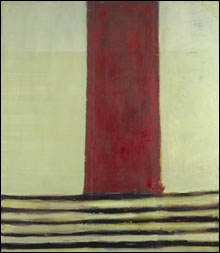 IN JUNE OF 1958, 22-year-old Malden native Frank Stella graduated from Princeton and moved to New York. The 21 works being shown in the Sackler Museum’s “Frank Stella 1958,” about half of what he made that year, reveal how enamored he was of Robert Rauschenberg and especially Jasper Johns. He swiped the stripes of Johns’s famous American-flag paintings and began trying out various arrangements of stripes and a rectangle rendered in cheap house paint. He aimed to supplant the Abstract Expressionists, whose work he thought had grown precious. “I sensed a hesitancy, a doubt of some vague dimension which made their work touching, but to me too vulnerable.”
IN JUNE OF 1958, 22-year-old Malden native Frank Stella graduated from Princeton and moved to New York. The 21 works being shown in the Sackler Museum’s “Frank Stella 1958,” about half of what he made that year, reveal how enamored he was of Robert Rauschenberg and especially Jasper Johns. He swiped the stripes of Johns’s famous American-flag paintings and began trying out various arrangements of stripes and a rectangle rendered in cheap house paint. He aimed to supplant the Abstract Expressionists, whose work he thought had grown precious. “I sensed a hesitancy, a doubt of some vague dimension which made their work touching, but to me too vulnerable.”
The paintings and assemblages he produced — reunited at Harvard for the first time in decades — are okay, but for me they’re the minor works of a major artist. The exhibition’s narrow focus, perfect for study (and eminently appropriate for an academic institution), shows you Stella thinking, making one experiment after another, until near the end of the year he hit on his great idea.
Hanging on the back wall is Morrow Castle, one of the three paintings that vie for the title of the first of Stella’s “Black Paintings.” When a selection was exhibited in the group show “Sixteen Americans” at New York’s Museum of Modern Art in December 1959, it made his name, even though the reviews then were mainly negative. He had eliminated the fussy layering, drips, and visible changes of the previous months. Instead he penciled out a series of “U” shapes nested inside one another, the top bunch facing up and the bottom bunch facing down. (Sharp eyes will note that the center stripe is not actually part of a “U” but zigzags from top to bottom). Following this guide, he painted each black stripe like a single uninflected brushstroke, with the raw canvas peeking through between each band. The result is simple, fresh, and clear and yet wobbles with mysterious energy and portent. The trick is that the geometric pattern bends slightly here and there, imbuing the potentially harsh regularity with a warm, handmade idiosyncrasy. Soon he would eliminate this too.
Over the next 25 years Stella’s cold, calculating formalism would be incredibly influential. He was nothing if not skilled at anticipating the style of his moment. It seems a generation of hack minimalists, Paul Rand’s striped IBM logo, the whole palette of the 1980s, and the geometric decoration that passes for architecture at most malls all owe some debt to him. But witnessing the warmth of the 1958 paintings again, you’re reminded it didn’t have to go that way.